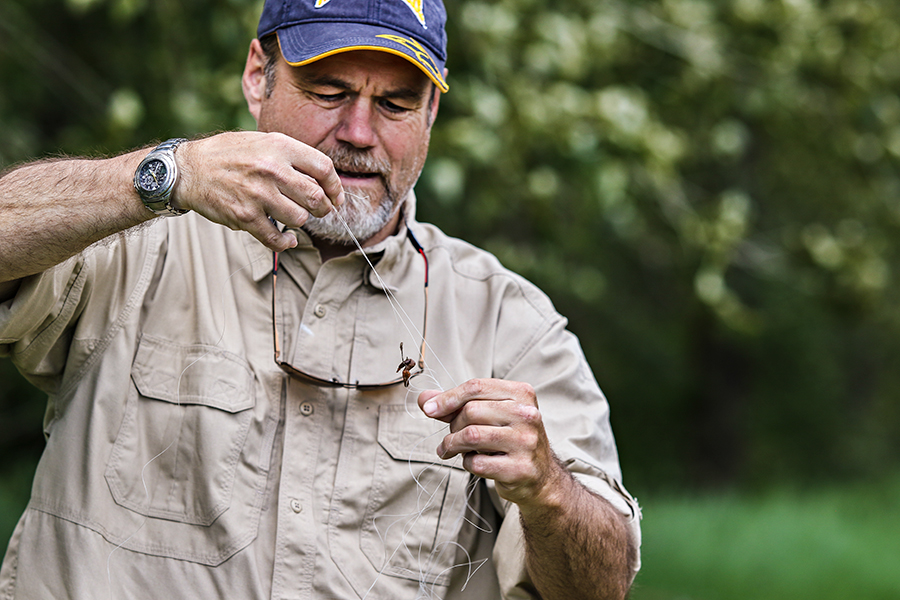FWP Proposes Extending Treble Tackle Ban to Entire Flathead River System
Fisheries managers are seeking public comment on regulations that would prohibit the use of ‘terminal tackle’ to minimize stress on sensitive species like westslope cutthroat and bull trout
By Tristan Scott
To reduce handling stress and hook-related injuries to native trout species, Montana Fish, Wildlife and Parks (FWP) officials are proposing to extend a ban on “terminal tackle” — treble hooks and double hooks — to the entire Flathead River system.
The proposed change comes as the state agency crafts its fishing regulations for the next two years and accepts public comment for the 2025-2026 angling seasons. The initial 64 proposals, which span the entire state, are available online for review and comment. FWP will collect comments through April 26.
Montana’s fishing regulations are split into three districts – west, central and east. Each district has standard regulations; however, many of FWP’s proposals remove exceptions to district standards that are no longer biologically relevant. Others are intended to increase fishing opportunity, enhance conservation efforts for some species, reduce confusion or improve enforceability, according to state officials. All regulation changes are based on criteria or objectives outlined in the Statewide Fisheries Management Plan.
In northwest Montana, a regulation change in 2020 restricted anglers to using single pointed hooks on the upper sections of the Flathead River, beginning upstream of Teakettle Fishing Access Site (U.S. Highway 2 bridge) and including all the three forks of the Flathead River — the Middle, North and South forks — as well as on all tributaries. The agency billed the change as a proactive measure to “reduce handling stress and hook-related injury to westslope cutthroat trout and bull trout amid increased use and pressure.”
Now, with an eye toward its 2025-2026 fishing regulations, FWP’s proposed change would extend the prohibition of terminal tackle from the confluence of the North and Middle forks downstream to Flathead Lake.
“In the case of single pointed hooks in the forks of the Flathead River, westslope cuthroat trout are very naïve to flies and lures and are known to be caught multiple times in a season and throughout their lives, making them exceptionally vulnerable to hooking mortality,” according to the proposal. “Single-pointed hooks make catch and release more effective while still allowing all types of fishing.”
In 2020, the Montana chapter of Trout Unlimited submitted public comment supporting the restrictions on double and treble hooks on the upper section of the Flathead River, where angling pressure has intensified, as has the unintended consequences of multi-pointed hooks on native fish species.
“We know that angling pressure on native fish in these waters has drastically increased in recent years and that increase is forecast to continue,” according to the organization’s public comment. “Our members have seen and heard from many local anglers and guides alarming and often fatal mouth damage (ripped mandibles, missing mouth parts) due to hooking-caused wounds, as well as reports of dead fish, likely due to poor playing and releasing techniques, dangerous terminal tackle and increasing angling pressure. Treble hooks play a large part in these wounds. We support efforts to eliminate the use of multi-pointed hooks in the Flathead River system. We believe that removing multi-point hooks from use on populations of threatened native fish will result increased survival and in better overall survival of the population. Again, Montana Trout Unlimited supports these proposals.”
Angling pressure has been increasing at a measurable rate on all three forks of the Flathead River for the past 15 years. Population estimates for westslope cutthroat trout in the three forks are relatively low (approximately 300-500 fish per mile), according to FWP research. Population densities for larger cutthroat trout (12 inches and greater) are even lower (typically 30-80 fish per mile). While those population numbers remain stable, approximately 45% of fish greater than 12 inches show signs of repeat catch, which indicates fish are being caught and released numerous times.
The combination of low-density fish populations with high levels of fishing pressure could lead to problems for the sensitive fish species, and the proposed regulation would be a proactive protective measure, according to FWP.

Bull trout, a native fish species listed as threatened under the Endangered Species Act, use all three forks as migratory corridors. Angling for bull trout is not allowed in the Middle and North forks but anglers can catch-and-release in the South Fork, and harvest two bull trout per season with a registered catch card.
Angler surveys and catch cards indicate increased pressure on bull trout, while annual surveys of spawning nests reveal a trend of declining redd counts.
Fishing regulations undergo a thorough review every two years.
In addition to meeting with angling and recreational groups across the state to discuss the fishing regulations, FWP is hosting public meetings to solicit feedback. FWP will use the input to refine the regulations proposals that will be considered by the Fish and Wildlife Commission in October. The commission will adopt, amend or reject the proposals at its October meeting.
The meeting schedule is as follows:
- Region 1: March 19, 6 p.m., Kalispell, 490 North Meridian Road (already occurred)
- Region 2: April 10, 6:30 p.m., Missoula, 201 Spurgin Road
- Region 3: March 28, 6 p.m., Bozeman, 1400 South 19th St.
- Region 4: April 4, 6 p.m., Great Falls, 4600 Giant Springs Road
- Region 5: March 14, 6:30 p.m., Billings, 2300 Lake Elmo Drive
- Region 6: March 13, 6 p.m., Glasgow, 1 Airport Road Region 7: March 21, 6:30 p.m., Miles City, 352 I-94 Business Loop